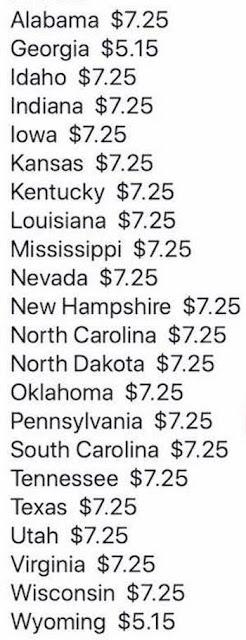 The federal minimum wage is $7.25 an hour (about $290 a week or $15,080 a year). It has not been raised in 20 years, and its' buying power is very low (and grows lower every year). The chart on the right shows the states that currently have a minimum wage at or below the federal minimum wage. Note those states are nearly half of all the states, and they have millions of workers.
The federal minimum wage is $7.25 an hour (about $290 a week or $15,080 a year). It has not been raised in 20 years, and its' buying power is very low (and grows lower every year). The chart on the right shows the states that currently have a minimum wage at or below the federal minimum wage. Note those states are nearly half of all the states, and they have millions of workers.If you oppose raising the minimum wage, then you obviously don't have to live on it, or try to support a family on it. The truth is that the federal minimum wage is not a livable wage (for a single person or a family). Paying a worker the federal minimum wage is forcing that worker to live in poverty -- and it constitutes a theft of labor by employers who do it.
The minimum wage must be raised, and not by just a tiny amount. It needs to be raised significantly -- and $15 an hour would not be too much.
Here's what the editorial board of The New York Times has to say about raising the minimum wage.
Opponents of minimum-wage laws have long argued that companies have only so much money and, if required to pay higher wages, they will employ fewer workers. Now there is evidence that such concerns, never entirely sincere, are greatly overstated. Over the past five years, a wave of increases in state and local minimum-wage standards has pushed the average effective minimum wage in the United States to the highest level on record. The average worker must be paid at least $11.80 an hour — more after inflation than the last peak, in the 1960s, according to an analysis by the economist Ernie Tedeschi. And even as wages have marched upward, job growth remains strong. The unemployment rate at the end of 2019 will be lower than the previous year for the 10th straight year. The interventions by some state and local governments, however, do not obviate the need for federal action. To the contrary. Millions of workers are being left behind because 21 states still use the federal standard, $7.25 an hour, which has not risen since 2009 — the longest period without an increase since the introduction of a federal standard in the 1930s. . . . House Democrats passed legislation in July that would gradually increase the federal standard, to $15 an hour in 2025 — likely raising the real value above the peak value in the late 1960s — and most of the Democrats running for president have endorsed the legislation. Last year, only about 430,000 people — or 0.5 percent of hourly workers — were paid the federal minimum. The share has fallen in recent years as state and local governments, and some employers, have stepped in. But a much larger group of workers stand to benefit, because they now earn less than the proposed minimum. The Congressional Budget Office estimated a $15 minimum hourly wage would raise the pay of at least 17 million workers Among the beneficiaries: people who work for tips. Federal law lets businesses pay $2.13 an hour to waiters, bartenders and others who get tips, so long as the total of tips and wages meets the federal minimum. The legislation would end that rule; the same minimum would apply to all hourly employees. Opponents of the change argue customers will curtail tipping and workers will end up with less money. But eight states, including Minnesota, Montana and Oregon, already have a universal minimum, including for tipped workers, and restaurant workers in those states make more money. Crucially, the legislation also would require automatic adjustments in the minimum wage to keep pace with wage growth in the broader economy. The current minimum rises only when Congress is in the mood. As a result, the purchasing power of the federal minimum wage has eroded by nearly 40 percent over the last half-century. A full-time worker making the minimum wage cannot afford a one-bedroom apartment in almost any American city. The simplistic view that minimum-wage laws cause unemployment commanded such a broad consensus in the 1980s that this editorial board came out against the federal minimum in 1987, calling it “an idea whose time has passed,” and citing as evidence “a virtual consensus among economists.” The old critique is still put forward regularly by the restaurant industry and other major employers of low-wage workers. But evidence that any such effects are relatively small has been piling up for several decades. A groundbreaking study published in 1993 by the economists David Card and Alan Krueger examined a minimum-wage rise in New Jersey by comparing fast-food restaurants there and in an adjacent part of Pennsylvania. It found no impact on employment. This prompted other economists to test the standard theory. This year, the British government asked the economist Arindrajit Dube to review the results accumulated over the last quarter-century. Mr. Dube reported the sum total of the research showed minimum-wage increases raised compensation while producing a “very muted effect” on employment. . . . The American economy is generating plenty of jobs; the problem is in the paychecks. The solution is a $15 federal minimum wage.

